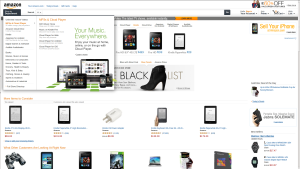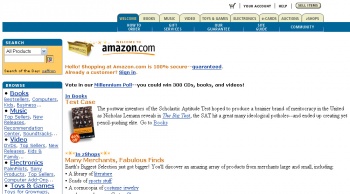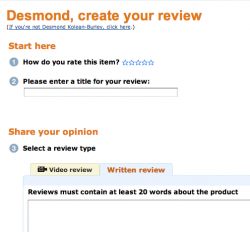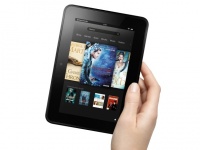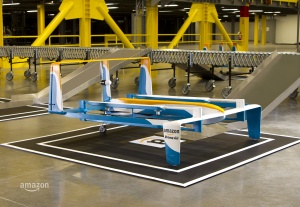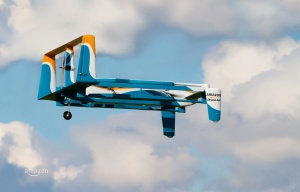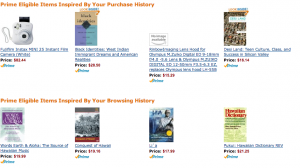Amazon.com
|
Contents
History
Jeff Bezos conceptualized Amazon.com in 1994 while working at D.E. Shaw & Co., a global investment management corporation. After weighing the pros and cons through a process he described as "regret minimization," he decided to leave D.E. Shaw in order to pursue his urge to found an online book selling company. Bezos believed e-commerce would become a very profitable business because the Supreme Court had recently decided online sales are not taxable. In addition, he believed online sales would follow a long-tail distribution, allowing Amazon.com to sell and carry books that would not be economical for a physical store to carry. Bezos sold his first book from his garage in 1995.[2]
Within the first month of launching the website, Amazon.com had a searchable database of one million books available and had received orders from all 50 states and 45 different countries. Amazon.com stocked roughly 2,000 of the most popular titles and would order the titles they did not stock from wholesalers and publishers. Jeff Bezos eventually moved Amazon.com's fulfillment center from his garage to an office location in Seattle once it was evident Amazon.com was becoming a highly successful operation. Between 1995 and 1997, Bezos added an additional half million titles, implemented an approach of discounting nearly all products by 10-30%, and created a review, recommendation, and notification system. In 1997, Amazon.com held its initial public offering of three million shares to raise capital for expansion. In order to minimize distribution time, Amazon.com opened a new distribution center in New Castle, Delaware. The new location minimized delivery times for both customers and amazon's internal orders from eastern publishing companies. Amazon.com also opened an "Associate" program, allowing other websites who hosted advertisements for books on Amazon.com to receive a commission of 8-15% if a consumer purchased the book after clicking on the ad. In October 1997, Amazon.com was the first website to announce reaching its one millionth customer. In March of 1998, Amazon.com had 2.6 million customers in its database, an increase of 1.6 million customers in just five months. Amazon.com continued to expand, entering the music business and purchasing IMDB in 1998. Between 1999 and 2001, Amazon.com's sales continued to climb; however, it continued to post net losses due to Bezos' focus on market share above profit. Many were skeptical of whether Amazon.com would turn a profit after losing over $1 billion over the course of seven years. In 2001, Amazon.com reported its first net profit, and in the second quarter of 2002, it reported its second net profit.[3]Website
Reviews
Consumers can review sellers and products listed on the company's website through text or video. Amazon Seller Reviews are a review of a third-party seller's performance in selling the good the consumer purchased. Customers who intend to purchase a product on Amazon browse through a list of third-party sellers to choose which seller they would like to purchase the product from. The review system displays the sellers' aggregate rating along with the total number of people who have reviewed the seller. Because there are thousands of seller, this rating system is crucial when trying to differentiate one user from another.
Amazon Product Reviews allow consumers to review the products they have purchased. The customer is emailed after the item has been shipped and received to review their experience with they seller. First, they are asked to give a 1-5 star overall rating of the product. Second, they require a title for the review. Finally, they ask for a detailed written review or a video review of the product. In addition to the seller rating, this can be a useful tool to prospective customers of a product.
Additionally, consumers can also review sellers of a product utilizing a numeric rating system from one to five. Seller profiles will display the average rating received over the last 365 days, lifetime average, as well as a history of all comments left by users. Generally, users will be encouraged to rate sellers after each purchase. [4]
Amazon Prime
Amazon Prime is a service that provides free two-day shipping on select items to customers who pay an annual amount for an Amazon Prime Membership. Currently, this membership costs $79 for US customers and is offered at $39 for students with a valid university email. In order for an item to be eligible for Amazon Prime, it must be either sold directly by Amazon.com, or a third-party seller must opt to have the item fulfilled by Amazon.[5] Third-party sellers interested in having an item fulfilled by amazon (FBA) send their inventory to an Amazon.com fulfillment warehouse, and Amazon.com will ship and provide all customer service for the item for a 10-12% fee.[6] Benefits of being an Amazon Prime member include Free Two-Day shipping (or an optional flat rate $3.99/item One-Day shipping option).
Media Access
Amazon Prime membership allows users to access some Kindle books that others cannot. In addition, a large feature of Prime is the access to Prime Instant Video. This free streaming service allows for many of Amazon's media available for purchase (such as TV shows and movies) to be streamed for free while connected to the internet. This service puts Amazon in competition with streaming services such as Netflix and Hulu. Though the cheapest of the three options (if compared on a per-month basis), it is considered one of the hardest to navigate and contains the least-updated content. In addition, it requires a constant internet connection instead of allowing content to load and then be disconnected from the internet. In addition to the access to streaming, Amazon Prime Instant Video directly incorporates Amazon's media purchasing platform into its streaming platform. In 2012, Prime Instant Video was incorporated into the newest Kindle's capabilities.
Third-Party Sellers
Roughly 40% of Amazon's profit is derived from its third-party sellers. Third-party sellers interested in selling on Amazon.com pay roughly an 8% commission to Amazon.com for products they fulfill. Sellers can opt to have their products fulfilled by Amazon.com for a 10-12% commission.[6][7] Amazon.com reported that 1.6 million sellers sold products through Amazon.com in 2009.[8] Unlike eBay payment for these products is handled directly through Amazon.com. Amazon offers two different plans for potential sellers to offer products through. These plans are Individual Seller and Professional Seller plans. Those who choose to follow the Individual Seller plan must pay $.99 for every item that they sell. In addition to this, they must pay selling fees, which vary per category. They are not charged a monthly subscription fee for these sales. Those following the Professional Seller plan must pay a monthly subscription fee of $39.99 per month, but do not have to pay the $.99 fee per each item that they sell. After a sale has occurred and the seller has sent verification to the buyer that their item has been shipped, Amazon processes the payment and the net proceeds are credited to the vendors Seller Account. Selling fees and refunds to buyers are debited against these amounts from sales on their account. A seller may request transfers of funds to be as frequent as every 24 hours, but the default transfer period is every 14 days. [9]
Products and Services
Retail Goods
Amazon.com sells a great selection of products including books, movies, music & games, electronics & computers, home, garden & tools, toys, baby products, grocery, beauty products, clothing, jewelry, industrial & scientific supplies, and sporting goods. Originally the company used the platform of web auctions service to sell its products. Unfortunately, it was an unsuccessful turn-out due to the existing competition with eBay. Amazon decided to change its platform to a fixed-price marketplace business. As the result, Amazon.com was established and started expanding its market in the year of 1999.
Amazon Kindle
The Amazon Kindle is an electronic device that allows users to download, store and read electronic books, also known as e-books. The user can access the Amazon store with more than 115 000 e-books. The Kindle allows the customers also to read newspapers, magazines, blogs and even hear audio books and other MP3 files.[10] The word Kindle means "to set fire, to start a fire"[11], which explains the name given Amazon's newer Kindle tablets: Kindle Fire. The tablet was named by Michael Cronan[12] and made by lab 126, a company owned by Amazon.com whose main goal is to produce high-tech products.[13] The Kindle Fire is the first generation of Kindle to have a color touch screen. Along with the 7" LCD display, the Kindle Fire uses Android software. The device has 8GB of storage and a projected battery life of up to eight hours. The Kindle Fire is now available in an HD format as well.[14]
Amazon Alexa (Amazon Echo)
The Amazon Alexa is an intelligent personal assistant developed by Amazon. Alexa responds to her voice command and is able to perform different tasks such as setting alarms, creating lists, searching the internet, providing weather and traffic real-time information, as well as playing music. This device is similar to Apple's Siri as it is considered a personal assistant. There are many ethical implications with Alexa such as privacy and security issues. [15]
Amazon Web Services
This division of amazon was founded in 2002 to rent cloud capabilities to clients. Among the 30 different services offered, Amazon EC2 (Amazon Elastic Compute Cloud) is the most prominent. It rents computation and bandwidth to clients on an adjustable basis that accommodates bandwidth usage, processing power, and the client's budget. [16] One of its main advantages is that it is easy to use. To set up an EC2 environment, clients select the operating system, services, databases, and application platform stack required for their applications.[17] Amazon EC2 provides a full management console and APIs to manage these consoles.[17] Amazon EBS (Elastic Block Store) is another AWS service. It is meant to support EC2 by offering a form of redundant networked storage.[18] Although it is indistinguishable from a local hard drive to the EC2 instance, Amazon claims that EBS instances offer redundancy and scaling that automatically protects EC2 instances against outages. [18]
However, this protection is not completely effective. Firstly, the redundancy mechanisms are only offered within the service region that a client subscribes to. [18] Secondly, past EBS outages have impaired and even completely shut down client services in the past. [16] Prominent services affected by outages include Reddit and Instagram among others. [16] Sites may be able to reduce their vulnerability by changing their back-end architecture to resist the failure of an individual storage device[19] Similarly, Amazon suggests that customers may protect themselves by purchasing service in multiple regions to provide back-up in case of any single-region outage. [18] However, it may be that the only safe way to avoid the type of failure suffered in past AWS blackouts is to avoid using EBS with EC2 altogether. [19] Despite the potential for EBS outages to shut down or impair a dependent site, many companies find the benefits of the service to outweigh the costs of occasional brief outages. [20].
Amazon Mechanical Turk
Amazon Mechanical Turk gives businesses and developers a means of a large, cheap, and temporary workforce. The website is based on the concept of crowd sourcing and the idea that some tasks require a human to complete them, rather than a computer. Such tasks are dubbed Human Intelligence Tasks, or "HITs", and range from typing recipes to writing captions on pictures to transcribing recordings. Each HIT pays very little to the worker once the requester approves the work, anywhere from a few cents to a few dollars. Workers may either transfer the payments to an Amazon gift card or to their bank account, but may only do so after at least $10.00 is earned.[21]
Requesters must have an Amazon account and register for Amazon Mechanical Turk usage. When a worker appropriately completes a task, the requester must then pay the worker and Amazon fees through their Amazon account. Workers must comply with Amazon Mechanical Turk's policies, such as not using the site for illegal purposes.[22]
Workers must also have both an Amazon account and register to use Amazon Mechanical Turk. Workers may view available HITs and work on any HITs in which they are qualified to do. They may request qualifications in order to complete more HITs. The payment reward, time allotted, and expiration date are among the details listed for each HIT.[23]
Amazon Exclusive Market
Amazon started its own label called "PINZON", and to expand the market, they further included more varieties of products and goods. The new trademark was registered in September 2008; however, Amazon has not yet received an official verification for the name.
Amazon.com exclusive consists of products that are only exclusive on Amazon.com. Most of the exclusive products are DVDs made by the owner or Amazon.com. Some DVDs producers partner with Amazon.com and allow their films to be sold on Amazon.com earlier than everywhere else. This gives Amazon.com an advantage to receive revenue before the actual date of release for the DVDs.
In 2009, Amazon.com also created a new product line called AmazonBasics, which sells consumer electronics products.
Amazon Prime Air
On December 1st, 2013 Amazon CEO Jeff Bezos announced to the public details about the company’s conceptual unmanned aerial vehicle (UAV) delivery program to be called Amazon Prime Air.[24] The delivery method promises to get certain packages ordered on Amazon to customers within 30 minutes of their purchase if they live within a set distance of Amazon Prime Air facilities.[25] Amazon Prime Air UAVs fly at a maximum speed of 55 mph beneath 400 feet and can deliver packages that weigh up to 5 pounds. The Amazon Prime Air UAV takes off and lands vertically but fly’s horizontally for maximum speech and efficiency. In order for the Prime Air UAV to make successful deliveries, customers are required to have an Amazon landing pad and a sufficient amount of clear space for the UAV to make a decent.[26]
Although Amazon has been getting closer to formerly releasing the service to customers in the United States, the United Kingdom, and Israel the company has faced numerous legislative and regulation battles with several government agencies. In the United States, the service had to win approval from the Federal Aviation Administration (FAA), which in 2015 granted Amazon Prime Air approval to begin testing the services current UAV prototype.[27] The new Amazon service has been met with mixed reactions and raised serious public concerns about safety and privacy.[28]
Amazon Services
Amazon maintains many of their acquisitions as subsidiaries, allowing them to be run as private companies while allowing Amazon access to certain aspects of their platform, such as advertising.
- A9 is a product and visual search technology provider that powers search for Amazon.com and other retail sites owned by Amazon. [29]
- AbeBooks is an online forum for books to be bought and sold. It allows small, independent bookstores to reach out to a larger audience using the internet, as their databases are searchable on AbeBooks. AbeBooks was acquired by Amazon in August 2008 [30]
- Audible is a book rental service that allows users to rent a certain number of books per month, depending on how much they pay. The books are available for viewing on most smart phone devices (iOS, Android, and Windows phones) in addition to being available on the Kindle. [31]
- Quidsi, Inc. was acquired by Amazon in November 2010. Quidsi operated the following sites:
- BeautyBar.com is an online boutique offering beauty products.
- Casa.com is an online retailer for home products.
- Diapers.com offers products parents of newborns and young children might use, such as diapers, car seats, and strollers. By ordering online, the price is cheaper.
- Soap.com is an online store for drugstore products, such as vitamins, health and beauty products, school supplies, and basic groceries.
- Wag.com is an online store for pet supplies.
- Vine.com is an online retailer offering organic and "green" products.
- Yoyo.com is an online toy store.
- Book Depository is an online book vender for all types of book mediums. It ships books for free to many countries, sells eBooks, and has books in the public domain available for download. Amazon acquired The Book Depository on July 4, 2011. [32]
- CreateSpace is the product of two companies: CustomFlix and BookSurge. Each was started as a means for creators of content to be able to publish and maintain control over their works. When each was acquired by Amazon, they were eventually merged to cover all content rather than their individual categories. CreateSpace allows content creators to distribute works across many mediums (digitally, in print, etc.). [33]
- Digital Photography Review is a database of digital camera-based content, such as lenses, cameras, and applications. It also includes active user-generated content areas such as discussions, buying guides, and reviews. Amazon acquired Digital Photography Review in May 2007. [34]
- Fabric.com is an discount fabric store selling textiles online. Amazon acquired Fabric.com in June 2008. [35]
- IMDb is a searchable database of all movies and TV shows, including information on the cast, crew, production, and plot summaries. Additional sections, such as movie trivia, have been added. The homepage of IMDb includes recent film reviews, statistics, and what's playing. Amazon acquired IMDb in 1998.
- Junglee.com was started by Amazon in February 2012 as an online store for purchasing a variety of items. It offers price comparisons with vendors both online and offline.
- MyHabit was started by Amazon in May 2011 as a flash-deal fashion website. Using the same model as other discount sites do, such as [Gilt.com|Gilt] and [hautelook.com|HauteLook], MyHabit offers daily deals on high fashion items at up to 60% off. MyHabit is members only; Amazon has an initial advantage over competitors because of their large network of users to begin with. [36]
- Shopbop is an online retailer selling women's fashion items. Though it is mostly online, Shopbop does maintain a storefront in Madison, Wisconsin. Each season, it has unique lines from designers. Shopbop was acquired by Amazon in February 2006. [37]
- Warehouse Deals is a subsidiary of Amazon's normal website, providing contents from warehouse and at, in theory, an even larger discount.
- Woot is an internet retailer offering one discounted item per day. It was acquired by Amazon on June 30, 2010.
- Zappos is an internet shoe retailer. It has expanded to include clothing, handbags, and home supplies. It is the largest online shoe store. In 2009, it was acquired by Amazon after serving independently for 10 years.
Amazon Prime Pantry
In 2014, Amazon introduced an exclusive Prime service called Amazon Prime Pantry[38]. Amazon Prime Pantry is a service that allows users to shop for household items and groceries from the comfort of their computer or phone. The service offers the same two day delivery as typical Prime orders but comes with a flat $5.99 delivery fee. With the addition of five or more "qualifying items" to one's order, however, this delivery fee is waived[39]. Prime Pantry allows shoppers to add up to 45 pounds worth of goods to their boxes and the service ships anywhere in the contiguous United States[40].
Aside from its direct grocery shipping service, Amazon has begun to use Prime Pantry as an incentive for users. Prime users are now offered five dollars of Pantry credit when they choose "No Rush Shipping" on other orders. This initiative from Amazon was made with the hope that some users would forfeit their free two day delivery while also giving users the incentive to being using Prime Pantry[41].
Amazon Prime Photos
In 2014, Amazon introduced an exclusive Prime service called Amazon Prime Photos. Amazon Prime Photos allows users to store unlimited photos and up to five gigabytes of videos and other media content on Amazon servers as part of their yearly subscription[42]. Unlimited photo storage was previously obtainable through Amazon with a $12 per year subscription to their "Unlimited Photos" package. With that feature being killed off in September of 2016, users who wanted to retain their unlimited storage were faced with the choice to pay for the yearly Prime subscription or give up their storage altogether[43].
In October 2016, Prime Photos added the feature "Family Vault". Family Vault allows one Amazon Prime subscriber to invite and open up the Prime Photos services to up to five non-Prime users. All five members along with the Prime subscriber are able to upload, download, organize, search, and purchase photos from Prime Photos. The service is available across all desktop platforms as well as Apple and Android mobile devices. The service cannot be subscribed to independently and must be accessed as a part of an Amazon Prime membership[42][44].
Amazon Go
In 2016, Amazon introduced a new grocery store service known as Amazon Go [45]. Currently, the technology is in a sort of "Beta" period with the only operating store in Seattle, WA, but more are potentially on the way. The store operates using similar technology to self-driving cars in order to create a shop that allows customers to simply walk in, take what they want, and leave, with the store automatically charging their Amazon account for the food that was taken [45]. Computer vision and sensors monitor when items are taken from and returned to shelves and keeps track of them in a virtual cart for each individual within the store [45].
Revenue
Amazon is one of the biggest retail stores in the world. It is currently the 15th largest retail store in the United States, the 56th largest store in America by market capitalization, and the largest Internet retailer.[46] Throughout 2012, Amazon experienced significant loss as a result of the acquisition of LivingSocial. In their Q3 earnings report, Amazon reported a $169 million loss as a result of the deal, contributing to the overall $274 million loss. [47]
Price Discrimination
In 2000, an account of price discrimination violating the Robinson-Patman Act was found on Amazon.com. A customer interested in buying a DVD discovered that after deleting his cookies, he was offered a lower price for the DVD. In addition, it was found that customers who had cookies from a bargain-hunter website were offered a substantially lower price ($51 less) on an mp3 player.[48]
Initial Public Offering (IPO)
In 1997, Amazon.com first issued its IPO. It is traded as the symbol AMZN under the NASDAQ stock exchange. It started at $18 per share and soon made $54 million [49]. Since its initial trade, Amazon.com's stock has increased to about $250 per share [50].
Effect on Small Businesses and Book Stores
In 2011, Amazon.com was sued for patent infringement by a small company called M-Edge. The suit was filed in Maryland about copying a personal electronic device jacket that was remotely similar to one that M-Edge had made [51]. M-Edge products had become top sellers, but Amazon quickly capitalized and was able to benefit from the relationship by making a new contract. This contract stated that fees on company sales would increase, and M-Edge would be required to pay an additional 7 percent in fees. Amazon not only manufactured a product that was a direct knock-off from M-Edge's company design, but their products were "de-listed" from Amazon's site [51]. Because Amazon has grown to be such a big company, it is easy for companies like M-Edge to be overseen.
Although Amazon.com is an online retailer, it has had negative impacts on businesses in the offline world. Amazon has driven many companies and stores to go out of business, since they are able to offer a wide variety of products in one place, often for lower prices than offline retailers. By making most all book titles available for purchase online even if they are not popular, Amazon has essentially shut down Borders and is outselling Barnes and Noble. Because Barnes and Noble stores can only house so many physical books, they have a limitation that Amazon does not possess. Since Barnes and Noble wants to increase their chances of turning a profit, they can only feature the top titles in their stores at a given time. Since they are then lacking the long tail of book possibilities that any consumer may want, they ultimately alienate many of their customers and cannot serve their needs, leading them to turn to online sources like Amazon.[52] However, in late 2011 Amazon introduced their Amazon Lending program, which provides small loans ranging from $1,000 to $38,000 to small businesses at interest rates ranging from less than 1% to 13.9%. [53]
Ethical Controversies
Review System
The Amazon.com review system has been challenged for its accuracy and integrity. In 2004, the New York Times discovered a number of Amazon book reviews were written by the authors themselves either promoting their own book or demoting their competitors' books.[54] The review system is also prone to being abused by internet trolls. Certain products such as the "Three Wolf Moon" t-shirt have gained media attention because of their exaggerated, and often fake, reviews claiming magic powers.[55] Because the reviews are subjective, they are inherently prone to a number of issues. Sellers can create fake accounts, use bots, or hire others to write good reviews for fake or illegitimate products in order to scam other customers. In addition, following 2012's presidential candidate Mitt Romney's comment about "binders of women", several different models of binders were plagued with reviews exclaiming the inability to hold women. By abusing this system, the system of evaluation lost some reputability for such products until Amazon took control of the situation. [56]
Therefore, the Amazon review system needs to be heavily moderated by Amazon in order to maintain a pure and legitimate standard for other users to use. Trolling and scheming can occur and deceive many users into buying products that turn out to be scams. There is even a site called Fakespot that has been designed to go hand in hand with Amazon reviews to see if the review is genuine. [57] This raises an ethical issue as to whether or not all of Amazon's products can be trusted.However, this moderation system from Amazon can sometimes block users with good intentions from giving their honest reviews on products. For instance, if a review is too short (or deemed to be not thorough enough by Amazon), the review can be rejected or taken down. Furthermore, it can sometimes be difficult for Amazon to determine the validity of a review. Amazon user Harriet Klausner received public backlash after posting more than 30,000 book reviews, all of which gave the books four- or five-star ratings. [58] According to Klausner, the quantity of her reviews was due to a medical condition which kept her homebound which, coupled with her insomnia, caused her to read multiple books a day. Furthermore, she explained that all of her reviews are positive because she only finishes books that she enjoys, and stated, "If I can make it past the first 50 pages, that means I like it, and so I review it" [59] Despite her explanations, many customers believed that Klausner must have been paid to post these reviews, which is a violation of Amazon's guidelines. [60]
Contactless Shopping
Amazon unveiled its first brick and mortar retail store, Amazon Go, which utilizes a form of contactless shopping. The user first logs into their Amazon Go App and adds then is tracked by sensors and computers as to which items they are adding into their baskets. This is described as "just walk out shopping" [61] and has only been adopted among the employees of Amazon. While the items have already been paid for, the lack of needing to engage with a cashier to pay for goods challenges a long-ingrained paradigm of purchasing, leaving customers feeling potentially theft-like upon leaving a store. Amazon further needs to consider the efficacy of the application in detecting items being picked up for purchased to prevent against theft and make sure users are logging in. While jobs for cashiers will not be necessary for this business model, Amazon is providing a lot of jobs to computer developers to continue working on the functionality of the contactless shopping.
eBook Ownership
Amazon came under criticism after releasing their e-book reader, the Kindle, when some purchasers realized that the books they buy are only licensed to them, and can be revoked at any time - Amazon's terms give rights only to view the content of the book.[62] Similar situations arise in most digital goods markets. As users commonly do not read the licensing agreement, many do not realize that they own only rights of usage - without physical property, there is nothing they can 'own.' Digital copies are considered intellectual property of the creator and ownership of others' creative property is illegal[63]. The company retains the right to delete customers' books, as well as to delete their accounts. This raises concerns for those considering the e-book to be their property. Some have complained that this resulted in a "bricked" Kindle, that is nearly useless.[64] It also raises the issue that once a kindle owner dies, the rights to the digital content they have purchased return to the seller, and cannot be left to family members as a physical item could[65].
Amazon Silk Web Browser
In September 2011, Amazon announced a new Kindle series, featuring an updated version of its web browser, Silk. This new browser predicts the webpage users are most likely to visit next and preloads it in order to accelerate the browsing experience. In addition, it compiles worldwide web browsing trends to make it easier to find popular websites and emerging stories. Many tech-savvy consumers reacted negatively to the browser because all browsing data is sent to Amazon, and it was unknown how Amazon planned to use this data. Recognizing the concerns of his constituents, Congressman Edward Markey wrote Jeff Bezos, asking, "What information does Amazon plan to collect about users of the Kindle Fire? How does Amazon intend to use this information? Does Amazon plan to sell, rent, or otherwise make available this information to outside companies?" Bezos responded to these concerns, explaining that firstly, all the information is encrypted and therefore consumers are protected; and secondly, he stated that although this is the default setting, consumers can turn off this feature.[66]
Recommender Services
Due to the nature of an Amazon account creation, user information becomes open and available for Amazon to use, analyze, and even recommend products that the customer might be interested in purchasing via a recommender system. The intelligent interface that Amazon utilizes allows for successful procedures to be implemented, such as customer profiling. Amazon gathers user information and uses personalization algorithms to recommend certain products to its customers based on other users who have been profiled as people with similar interests, hobbies, or likes. The goal of the recommender services is to effectively sell more products and save users time by pointing out products the user might be interested in given the user's background information. The act of automatic online profiling is unfavorable for many users because they may feel as though personal information is being used to create an inaccurate depiction of his or her identity. For example, the Amazon recommender system might make inappropriate or misleading recommendations to a user based on its harvesting of their personal data, preferences, searches, and likes. While this system might be able to benefit the user with recommended products that the user would like to view, it can also raise ethical concern by misinterpreting user preferences and turn off potential customers. No ethical guidelines for these algorithmic profiling procedures are in place yet, and in fact, many people do not even know that e-commerce companies such as Amazon are manipulating user personal data in such a way, which is an ethical issue in itself. [67]
Amazon and Zappos.com
In 2009, Amazon and Zappos joined forces, or in legal terminology, "Zappos will be a 'wholly-owned subsidiary' of Amazon" [68]. CEO of Zappos, Tony Hsieh, describes the relationship between Zappos and Amazon very positively and equally. He goes on to explain that the reasons for joining Amazon is because Amazon was the best partner to help them grow, Amazon encourages them to continue as an independent entity, and both companies thought process are on the same page and in each other's best interests[69].
However, about one year ago, Amazon.com was sued because of an accusation by a customer of the Zappos.com unit that someone had hacked into the system and obtained personal and account information. [70]. About 24 million Zappos customers received e-mails about their account numbers being compromised, and although no credit card information was gathered, there lies an ethical issue of failing to protect the privacy of the customers and partnership with Zappos. Amazon, however, is taking action in response to these events by paying for credit monitoring and identity theft insurance. With the huge growth of Amazon and Zappos over the past few years, it is imperative that the privacy of customers are protected because without security, customers become skeptical and unwilling to purchase items from the site in case of situations that happen like this. Thankfully, no credit card information was revealed, but if this were to happen again in future situations, both companies may lose the trust of their customers. Customers today are still at risk of a hack on Amazon servers that would put millions of credit card information in jeopardy. The company has ultimately taken responsibility and careful measures to ensure the privacy and security of its users though.
Tax Avoidance
Shoppers on Amazon usually become repeat shoppers as they do not pay sales tax on purchases made. The exception are those states that have Amazon distribution centers and employees working in them. Jeff Bezos, the CEO of Amazon stated that collecting sales tax in states where employees are not present would be "unconstitutional" [71] Through this loophole, Amazon has avoided over 1 billion dollars in taxes, which raises an ethical concern with the United States government and tax laws. [72]
This tax avoidance has become a large controversy between the United States government and Amazon. Because these excluded states are losing money due to not collecting taxes, there have been laws proposed in order to collect taxes from Amazon. [73]
Worker Conditions
Amazon has faced a lot of criticism from past and current workers about the company's worker conditions, most specifically in the warehouses. Workers have released hundreds of stories about working in below freezing temperatures in the winter, in extreme heat during the summer; these workers walk well over ten miles a day. These ethical concerns are for the most part unknown to the public and are kept secret and subtle by Amazon in order to protect the image and reputation of the company. In certain warehouses, Amazon arranged for paramedics to be stationed outside the warehouses to assist workers who pass out from their work due to manual labor and heat conditions. [74] Amazon drivers have also sued the company in October of 2016 claiming they had to follow rules like employees, but were treated and paid as independent contractors.[75] Amazon may be a particularly difficult place for women to work, only 38% of reviewers on Fairygodboss responded that men and women are treated equally. Only a third of women at Amazon said they would recommend working at Amazon to other women.[76]
Commercial Drones
As discussed previously, Amazon has been testing drones in a program called "Amazon Prime Air" that aims to increase the efficiency of their current delivery services. There are, however, serious ethical concerns surrounding the use of such an object for commercial purposes and how it could effect the privacy of Amazon customers, particularly among representatives in congress*. Rep. Ted Poe, a member of the Republican Party and representative of Texas, has expressed concern over the drones' ability to gather information about individuals' homes and their properties via pictures*. He is not alone; in anticipation of the product, and other similar commercial drones, Rep. Ed Markey, a Democrat representing Massachusetts, to safeguard individuals from potential privacy breaches at the hands of drones like Amazon Prime Air*. Furthermore, others are concerned that the commercialization of high-technology objects like drones could spur breaches in not only individual privacy, but also national intelligence and widespread harm to civil liberties*.
See Also
External Links
References
- ↑ Internet Retailer. "Top 500: The World's Most-Trusted E-Commerce Resource." Retrieved on 5 November 2012.
- ↑ 2.0 2.1 2.2 Byers, Ann. "Jeff Bezos: The Founder of Amazon.com." 2007. Retrieved on 5 November 2012.
- ↑ Funding Universe."History of Amazon, Inc." Retrieved on 5 November 2012.
- ↑ Amazon. "About Comments, Feedback, & Ratings." Retrieved on 5 November 2012.
- ↑ Amazon."Prime Member Exclusives." Retrieved on 5 November 2012.
- ↑ 6.0 6.1 Amazon Services. "Fulfillment by Amazon Revenue Calculator." Retrieved on 5 November 2012.
- ↑ Amazon."Fulfillment by Amazon/" Retrieved on 5 November 2012.
- ↑ Szukutak, Tom."Market Watch: Third-Party Sales Fuel Overall Amazon Growth." 11 June 2009. Retrieved on 5 November 2012.
- ↑ Amazon. "Selling on Amazon: FAQ." Retrieved on 5 November 2012.
- ↑ Deb."What is a Kindle?" 23 October 2012. Retrieved on 31 October 2012.
- ↑ Etmyolnline. "Online Etymology Dictionary."Retrieved on 5 November 2012.
- ↑ Friedman, Nancy."How the Kindle Got Its Name." 11 December 2008. Retrieved on 5 November 2012.
- ↑ Friedman, Nancy."How the Kindle Got Its Name." 11 December 2008. Retrieved on 5 November 2012.
- ↑ Murph, Darren."Amazon Fire Tablet Unveiled 7-inch Display $199 price tag." 28 September 2011. Retrieved on 5 November 2012.
- ↑ [1] Retrieved 10 April 2017.
- ↑ 16.0 16.1 16.2 Hutchinson, Lee. "Amazon Web Services outage once again shows reality behind "the cloud."" 22 October 2012. Retrieved on 5 November 2012.
- ↑ 17.0 17.1 Amazon. "AWS Application Support." Retrieved on 5 November 2012
- ↑ 18.0 18.1 18.2 18.3 Amazon. "Amazon Elastic Block Store (EBS)." Retrieved on 5 November 2012.
- ↑ 19.0 19.1 twilio. "Why Twilio Wasn't Affected by Today's AWS Issues." 22 April 2011. Retrieved on 5 November 2012.
- ↑ Lunden, Ingrid. "Could Instagram and Other Sites Avoid GOing with Amazon's Ship?" 30 June 2012. Retrieved on 5 November 2012.
- ↑ Amazon Mechanical Turk."FAQ." Retrieved on 5 November 2012.
- ↑ Amazon Mechanical Turk: How do I pay for HITs?
- ↑ Amazon. "Mechanical Turk." Retrieved on 5 November 2012/
- ↑ ” Amazon unveils futuristic plan: Delivery by drone”. 60 Minutes. http://www.cbsnews.com/news/amazon-unveils-futuristic-plan-delivery-by-drone/
- ↑ ” Drone Wars has a new front on Retailers, Amazon Prime Air Drone unveiled”. Cincinnati Daily Science. http://www.albanydailystar.com/business/drone-wars-has-a-new-front-on-retailers-amazon-prime-air-drone-unveiled-cincinnati-daily-science-12139.html
- ↑ Pogue, D. (2016). “Exclusive: Amazon Reveals Details About Its Crazy Drone Delivery Program”. Yahoo Tech News. https://www.yahoo.com/tech/exclusive-amazon-reveals-details-about-1343951725436982.html
- ↑ Lavars, N. (2015). “Amazon to begin testing new delivery drones in the US”. Gizmag. http://www.gizmag.com/amazon-new-delivery-drones-us-faa-approval/36957/
- ↑ Singer, P. (2013). “The Predator Comes Home: A Primer on Domestic Drones, their Huge Business Opportunities, and their Deep Political, Moral, and Legal Challenges”. Brookings. http://www.brookings.edu/research/papers/2013/03/08-drones-singer
- ↑ Wikipedia."A9." Retrieved on 10 April 2017.
- ↑ Wikipedia."AbeBooks." Retrieved on 5 November 2012.
- ↑ Audible."Audible Pricing." Retrieved on 5 November 2012.
- ↑ Wikipedia. "The Book Depository." Retrieved on 5 November 2012.
- ↑ Createspace. "About Us." Retrieved on 5 November 2012.
- ↑ Wikipedia. "Digital Photography Review." Retrieved on 5 November 2012.
- ↑ Gonsalves, Antone."Amazon.com Acquires Fabric.com." 25 June 2008. Retrieved on 5 November 2012.
- ↑ Martinez, Amy."Amazon Launches a Flash Sales Site." 3 May 2011. Retrieved on 5 November 2012.
- ↑ Business Insider. "Shopbop in Business Insider." Retrieved on 5 November 2012.
- ↑ Granite, Matt. Save of the Day: Amazon introduces Prime Pantry. 02 May. 2014. "USA Today"
- ↑ Amazon. What is Prime Pantry? 2017 . "Amazon"
- ↑ Condliffe, Jamie. Amazon Prime Pantry: 45 Pounds of Groceries Delivered for $6. 04. Apr. 2014 . "Gizmodo"
- ↑ Amazon. About FREE No-Rush Shipping. 2017 . "Amazon"
- ↑ 42.0 42.1 Amazon. FAMILY PHOTOS TOGETHER AT LAST. 2017 . "Amazon"
- ↑ Zhang, Michael. Amazon is Killing Off its $12/Year Plan for Unlimited Photo Storage. 22. Sept. 2016 . "PetaPixel"
- ↑ Fox Rubin, Ben. Amazon Prime Photos unlimited storage can now be shared. 18. Oct. 2016 . "c|net"
- ↑ 45.0 45.1 45.2 "Amazon Go." Retrieved on April 17, 2017. https://www.amazon.com/b?node=16008589011
- ↑ Matthews, Christopher."Will Amazon Take Over the World." 16 July 2012. Retrieved on 1 December 2012.
- ↑ Weisenthal, Joe."Amazon Announces A Gigantic Loss On Its LivingSocial Investment." 25 October 2012. Retrieved 9 December 2012.
- ↑ Ramasastry, Anita. "Web Sites Change Prices Based On Customers' Habits." 24 June 2005. Retrieved on 5 November 2012.
- ↑ Kawamoto, Dawn. "Amazon.com IPO Skyrockets."15 May 1997. Retrieved on 11 December 2012.
- ↑ Google Finance. "AMZN Stock" Retrieved on 11 December 2012.
- ↑ 51.0 51.1 Ciccone, Alicia. "M<-Edge Files Lawsuit Against Amazon for Patent Infringement, Fraud." 28 December 2011. Retrieved on 5 November 2012.
- ↑ OnPoint."The Amazon Economy." 12 July 2012. Retrieved on 1 December 2012
- ↑ Needleman, Sarah and Bensinger, Greg. "Small Businesses Are Finding An Unlikely Banker: Amazon." 4 October 2012. Retrieved on 9 December 2012.
- ↑ Harmon, Amy. "Amazon Glitch Unmasks War Of Reviewers." 14 February 2004. Retrieved on 9 December 2012.
- ↑ Tom. "Three Wolf Moon." 21 May 2009. Retrieved on 9 December 2012.
- ↑ Perez, Sarah. "Binder Reviews on Amazon.com Fill with Romney-Related Comments." 19 October 2012. Retrieved on 7 December 2012.
- ↑ Dunn, Jeff. "You should always check these two web sites before buying anything on Amazon" 2 June 2016. Retrieved on 7 April 2017.
- ↑ Fitzgerald, Sandy. "Amazon Taking Down Thousands of Suspect Book Reviews" 23 December 2012. Retrieved on 9 April 2017
- ↑ Streitfeld, David. "Giving Mom’s Book Five Stars? Amazon May Cull Your Review" 22 December 2012. Retrieved on 9 April 2017
- ↑ Kaplan, Sarah. "The woman who wrote 31,014 Amazon book reviews and upended the Internet, dead at 63" 29 October 2015. Retrieved on 9 April 2017
- ↑ https://www.engadget.com/2016/12/05/amazon-go-grocery-store/
- ↑ Patrizio, Andy. "You Don't Own Your Amazon Kindle eBooks." 9 November 2012. Retrieved on 5 December 2012.
- ↑ Stern, Joanna. "Willis or No Willis: Passing on Your Downloads When You Pass." 4 September 2012. Retrieved on 10 December 2012.
- ↑ Ian. "Mobile Read: Amazon has banned my account - my Kindle is now a (partial) brick." 6 March 2009. Retrieved on 11 December 2012.
- ↑ Stern, Joanna. "Willis or No Willis: Passing on Your Downloads When You Pass." 4 September 2012. Retrieved on 10 December 2012.
- ↑ Marshall, Gary. "Is Amazon Silk sinister, or just speedy?" 31 October 2011. Retrieved on 5 November 2012.
- ↑ De Vries, K. (2010). Identity, profiling algorithms and a world of ambient intelligence. Ethics and Information Technology, 12(1), pp. 71-85.
- ↑ http://blogs.zappos.com/blogs/ceo-and-coo-blog/2010/07/22/amazon-zappos-1-year-later
- ↑ Hsieh, Tony. "Amazon & Zappos, 1 Year Later." 22 July 2010. Retrieved on 7 November 2012.
- ↑ Business Week.[2] 18 January 2012. Retrieved on 12 November 2012.
- ↑ McMillan, Graeme. "Why Doesn't Amazon Collect Sales Tax? Because of the Constitution, That's Why." 18 May 2011. Retrieved on 10 December 2012.
- ↑ Bergin, Tom."Special Report: Amazon's billion-dollar tax shield." 6 December 2012. Retrieved on 12 December 2012.
- ↑ Knox News. "Amazon Feels Heat Over Sales Tax Controversy." 1 June 2011. Retrieved on 10 December 2012.
- ↑ Soter, Spencer. [3] 17 August 2015. Retrieved on 15 April 2016.
- ↑ White, Martha. "Amazon Drivers Sue for Not Being Paid As Employees". Time, 5 Oct. 2016. 16 Apr. 2017. http://time.com/money/4520097/amazon-driver-suit/
- ↑ Tulshyan, Ruchika. "Why Microsoft ranks higher for women employees than Amazon" The Seattle Times, 22 Nov. 2016. 16 Apr. 2017. http://www.seattletimes.com/nwshowcase/careers/why-i-listen-when-women-say-their-company-is-great-to-work/

